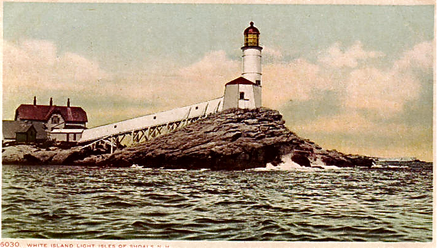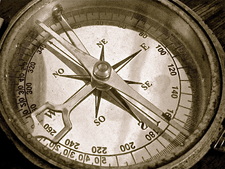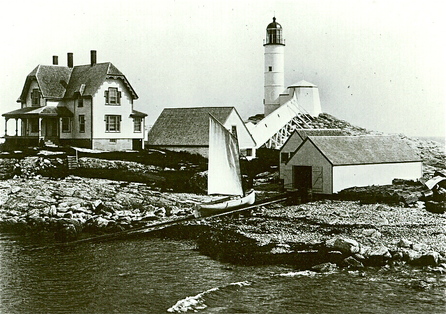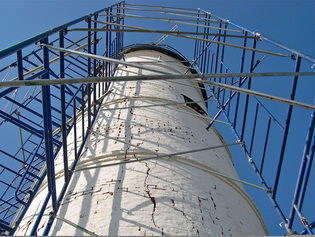White Island Lighthouse History

Historic Introduction - The Ravages of Time
The first lighthouse at the Isles of Shoals was erected on White Island in 1820. It was made out of stone and wood shingles. At one time in the early years, the lighthouse had patriotic flashing red, white and blue lights. The blue light was discontinued because of its dimness. In 1838 it was one of the first lighthouses to have a Fresnel light installed. The lighthouse was too low for a satisfactory test of this. A different lighting device was installed in 1841, although according to I.W.P. Lewis, "The whole construction of the apparatus bears the mark of rude workmanship." The lamps and reflectors were not replaced with a more efficient Fresnel light until 1855. In 1859 the present tower was constructed.
New Hampshire's most famous poet, Celia Thaxter, lived on the island for several years. Celia moved out to the island when she was four. Her father had been appointed lighthouse keeper. She came to love the island and when she got older and moved to the mainland her house was like a jail to her. She couldn't wait to go to the Isles of Shoals for the summer. Celia's poetry about the islands made her famous and attracted a lot of attention to the area! At age 59, during a summer on Appledore Island, Celia passed away. People believe that her spirit stills wanders around the islands.
The 1859 tower was built by the United States government to help fortify the seacoast. This is the tower that stands on White Island today. It is built from bricks and stone and stands 85 feet above mean high water. Although this lighthouse was constructed with the best materials available at the time, a century's worth of vicious winter storms took their toll causing large cracks, which placed the historic tower in serious danger of collapse.
White Island Historic Timeline

White Island's few residents include pirates.
Colonial Times (1600-late 1700s) - White and Seavey islands were most likely named for early owners. Pirates frequented the Shoals. Blackbeard may have buried treasure at the Shoals. Pirate Sandy Gordon died when his ship the Flying Scott sunk southwest of the Shoals. Sandy never returned to his home on White Island. It's claimed that his bride, Martha, was left there for the rest of her life.
1820 - The first lighthouse on White Island was constructed of rubble stone and then covered with wood and shingles for protection against the elements. The first keeper's cottage was a simple dwelling built of rubble stone. The U.S. Secretary of the Treasurer supervised all lighthouse keepers.
1839 to 1846 - Thomas Laighton was lighthouse keeper on White Island. In 1939 Thomas, his wife Eliza, their four-year-old daughter Celia, and three-month-old son Oscar all went to live on White Island. That same year a fierce gale raged off the New England coast. The Laighton family was safe in the keeper's cottage while they heard the distress signals of a boat passing close by White Island There were no survivors when the brig Pocahontas was wrecked on a sandbar on the mainland. In 1841 Thomas and Eliza's youngest son, Cedric, was born.
Mid-1840s - The Laightons moved to Smuttynose Island where Thomas Laighton revived the Isles of Shoals fishing industry and opened The Mid Ocean House to accommodate guests. In the years to follow, the Laightons transformed the Isles of Shoals into a favorite destination for artists, writers, musicians and other notable clientele. Celia Laighton Thaxter became a famous author of both prose and poetry.
1852 - Oct 09, United States Lighthouse Service was established to supervise lighthouses and their keepers.
1850s - With the help of one assistant, temporary lighthouse keeper John Bragg Downs courageously managed to rescue the entire crew of a Russian brig which grounded on White Island in a gale!
1859 - The 58' cylindrical brick tower was constructed. A number two order Fresnel lens was installed as the beacon. (This is the lighthouse which stands today.)
1878 - An ornate Victorian keeper's cottage was built and the original keeper's cottage was used for storage. The new house was a duplex with quarters for the families of the keeper and assistant keeper.
1820 - The first lighthouse on White Island was constructed of rubble stone and then covered with wood and shingles for protection against the elements. The first keeper's cottage was a simple dwelling built of rubble stone. The U.S. Secretary of the Treasurer supervised all lighthouse keepers.
1839 to 1846 - Thomas Laighton was lighthouse keeper on White Island. In 1939 Thomas, his wife Eliza, their four-year-old daughter Celia, and three-month-old son Oscar all went to live on White Island. That same year a fierce gale raged off the New England coast. The Laighton family was safe in the keeper's cottage while they heard the distress signals of a boat passing close by White Island There were no survivors when the brig Pocahontas was wrecked on a sandbar on the mainland. In 1841 Thomas and Eliza's youngest son, Cedric, was born.
Mid-1840s - The Laightons moved to Smuttynose Island where Thomas Laighton revived the Isles of Shoals fishing industry and opened The Mid Ocean House to accommodate guests. In the years to follow, the Laightons transformed the Isles of Shoals into a favorite destination for artists, writers, musicians and other notable clientele. Celia Laighton Thaxter became a famous author of both prose and poetry.
1852 - Oct 09, United States Lighthouse Service was established to supervise lighthouses and their keepers.
1850s - With the help of one assistant, temporary lighthouse keeper John Bragg Downs courageously managed to rescue the entire crew of a Russian brig which grounded on White Island in a gale!
1859 - The 58' cylindrical brick tower was constructed. A number two order Fresnel lens was installed as the beacon. (This is the lighthouse which stands today.)
1878 - An ornate Victorian keeper's cottage was built and the original keeper's cottage was used for storage. The new house was a duplex with quarters for the families of the keeper and assistant keeper.
The 1900s

The Victorian keepers' cottage was dismantled in the early 1950s.
1915 - United States Coast Guard was formed.
1939 - July 01, The United States Coast Guard took over the supervision of lighthouses. Instead of Lighthouse Service keepers, it was the duty of Coast Guard officiers to man the station.
Early 1950s - The Victorian keeper's cottage was dismantled and a more modern facility was erected on the foundation of the original keeper's cottage.
1978 - A huge blizzard, called "The Blizzard of 1978," sent waves crashing over the island. The boat house was swept into the sea. After a 300-pound rock smashed through the wall of the keeper's cottage flooding it, Coast Guard officers took refuge in the tower. Luckily the covered walkway remained in tact, so they had an escape route to the tower!
1986 - Oct 10, The White Island Lighthouse officially became automated which meant that Coast Guard officiers were no longer needed on the island. Without regular maintenance, the property started falling into a state of disrepair.
1992 - U.S. Coast Guard gave White Island back to the state of New Hampshire. The Coast Guard would still maintain the light as a navigational aid. White and Seavey islands, including buildings/structures became the responsibility of the N.H. Department of Resources and Economic Development, Division of Parks and Recreation. The N.H. Parks Department operates on revenues collected from tourists. There are very few tourists visiting the remote White Island Lighthouse. The Lighthouse Station's state of neglect grows more severe.
Mid-1990s - An "Artist in Residence" program was initiated on White Island. Artists, writers and musicians had the opportunity to sign up for a one-month tranquil and solitary summer stay on White Island. A few signed on; a few lasted the month and some art was created.
Late 1980s - The Fresnel lens was removed and replaced with a solar powered optic light. The tool shed was washed away in an ocean storm.
1998-2002 - Don Stevens of Atlantic Aquasport in Rye, N.H. had an agreement with the state of N.H. to bring divers to the island.
1939 - July 01, The United States Coast Guard took over the supervision of lighthouses. Instead of Lighthouse Service keepers, it was the duty of Coast Guard officiers to man the station.
Early 1950s - The Victorian keeper's cottage was dismantled and a more modern facility was erected on the foundation of the original keeper's cottage.
1978 - A huge blizzard, called "The Blizzard of 1978," sent waves crashing over the island. The boat house was swept into the sea. After a 300-pound rock smashed through the wall of the keeper's cottage flooding it, Coast Guard officers took refuge in the tower. Luckily the covered walkway remained in tact, so they had an escape route to the tower!
1986 - Oct 10, The White Island Lighthouse officially became automated which meant that Coast Guard officiers were no longer needed on the island. Without regular maintenance, the property started falling into a state of disrepair.
1992 - U.S. Coast Guard gave White Island back to the state of New Hampshire. The Coast Guard would still maintain the light as a navigational aid. White and Seavey islands, including buildings/structures became the responsibility of the N.H. Department of Resources and Economic Development, Division of Parks and Recreation. The N.H. Parks Department operates on revenues collected from tourists. There are very few tourists visiting the remote White Island Lighthouse. The Lighthouse Station's state of neglect grows more severe.
Mid-1990s - An "Artist in Residence" program was initiated on White Island. Artists, writers and musicians had the opportunity to sign up for a one-month tranquil and solitary summer stay on White Island. A few signed on; a few lasted the month and some art was created.
Late 1980s - The Fresnel lens was removed and replaced with a solar powered optic light. The tool shed was washed away in an ocean storm.
1998-2002 - Don Stevens of Atlantic Aquasport in Rye, N.H. had an agreement with the state of N.H. to bring divers to the island.
2000 to date

The lighthouse tower's coating was replaced in 2005.
2000 - N.H. Audubon Society and N.H. Fish and Game Department began the Tern Restoration Project on Seavey Island.
2000 - Led by teacher Susan Reynolds, a community service group of 7th graders from North Hampton School (North Hampton, N.H.) began efforts to save White Island Lighthouse.
2003 - On April 30, 2003 in Washington D.C., Senator Judd Gregg presented Lighthouse Kids with a $250,000, "Save America's Treasures" matching grant. In September the N.H. governor and council approved a Memorandum of Agreement between the state of N.H. and Lighthouse Kids. Lighthouse Kids started working as partners with the state to raise the funds necessary for the restoration and maintenance of White Island's historic facilities.
2005 - Ricci Construction of Portsmouth N.H. repaired the historic brick tower, put a new roof on the keeper's cottage, replaced several leaky windows and repainted the keeper's cottage. The lighthouse tower's coating was replaced in 2005.
2007 - On April 19 a vicious ocean storm wreaked havoc on White Island! The newly replaced lower window on the northeast face of the tower was dislodged and pushed in, the whitewashing below the window was washed off, the covered walkway between the keeper's cottage and tower was destroyed. The foghorn and solar panels for the navigational system were also destroyed. The United States Coast Guard repaired the navigation equipment; plus they repaired the helicopter landing pad! Bill Purdy of New Hampshire Glass went out and repaired the damaged tower window. Pickering Marine of Portsmouth N.H. constructed a new marine railway with donated funds from Lighthouse Kids and Striped Bass Association.
2008 - New England Lighthouse Lovers (NELL) donated $5,200 to replace leaky windows in the keeper's cottage. Federal funds were appropriated to replace the covered walkway.
2009 - Ricci Construction of Portsmouth N.H. completed several updates and repairs on White Island. Most importantly, the lower portion of the lighthouse tower was resurfaced by Edison Coatings, www.edisoncoatings.com. This coating has a 10-year warrantee and is the material used on Portland Head Light and Pemaquid Point Light in Maine. Footings for a new covered walkway were constructed. Plans were made for the covered walkway to be constructed in 2011. All the windows in the keeper's cottage were replaced and storm windows were installed. The easterly gable end of the keeper's cottage was repaired to prevent water access to the interior of the cottage.
2010 - Rotting timber frames, gutters, trim boards and all clapboards on the northerly side of the keeper's cottage were replaced by Arsenault Construction of Rye, N.H. The northern and easterly exterior was painted.
2010-2011: The foundation was laid to begin a Stewardship Program on White Island with a goal to get underway during the summer of 2011.
Volunteers went to White Island to clean up before the winter season. The winch on the marine railway was taken to the mainland for winter repairs and maintenance.
2011 -- In late summer and early fall the iconic covered walkway was replaced by Thurston Timber Framers of Concord, N.H. Major construction on an island requires innovation and Jeff Thurston leveraged it during both construction and transportation. The frames were built in his Concord workshop; then Riverside Marine was hired to transport the frames and all building materials to White Island aboard its barge. A helicopter was hired to move all materials from the barge onto the island. The helicopter was able to pick up the frames one at a time, then lower each frame into place. Lighthouse Kids watched as the framing for the covered walkway went together like pieces of a jigsaw puzzle in just a few hours. Additionally, Jeff Thurston’s crew lived in the keepers’ cottage throughout the construction. The expense of transportation to and from an island site for daily work was eliminated. The covered walkway is a marvelous testament to Yankee engineering! Lighthouse Kids installed and began to maintain a mooring for steward and state use in the cove adjacent to the marine railway.
2012 – The Lighthouse Kids Stewardship Program began in earnest. Blue Ocean Society did a trap, buoy and fish line cleanup. A new battery bank was purchased for the solar power. CPH Mechanical was hired to update the propane system in the keeper’s cottage. The propane system is now modernized.
2013 – The Stewardship Program successfully expanded and stewards continued to repair and clean. The United States Coast Guard Notice to Local Mariners temporarily placed White Island Lighthouse Station on the disabled list. Due to severe weather the Coast Guard had a long list of navigational aids that were in need of repair. In the spring and for most of the summer the light and foghorn were extinguished. Lighthouse Kids board members were persistent in contacting the Coast Guard to check on repair. In September, with a fair weather window, the Coast Guard workers arrived on the island to make the repairs. New Hampshire’s only offshore lighthouse was once again operational!
2014 – The salt water environment and rough water exposure caused severe deterioration to the walkway alongside of the marine railway used for access to the island from a skiff. Materials were purchased and Riverside Marine was hired to replace the metal platform on walkway. THE WALKWAY IS REPAIRED! While landing on White Island remains a challenge, it is much safer now. The light and foghorn were again extinguished for a few months, but the Coast Guard once again repaired the aid to navigation.
2015 – During the winter, Seacoast New Hampshire and Southern Maine was battered with severe storms and heavy snowfall. Thanks to the close-up efforts of stewards in the fall of 2014, White Island Lighthouse Station facilities fared well, although the light was once again extinguished. This time the Coast Guard’s solar panels were destroyed. Without a means to charge the tower batteries, the light and foghorn were once again nonfunctional. Again the Local Notice to Mariners listed the light as extinguished. Because of the heavy damage to many lighthouses and navigational buoys along the coast, White Island had to wait its turn for repairs. USCG solar panels and batteries were installed at summer’s end and as 2015 grew to a close, the light could be seen each night from the coast. Luckily, the keepers’ cottage solar panels and batteries are located in a more protected area and survived unscathed. Stewards continued to perform the ongoing tasks of: opening for the season, closing-up, hosting visitors, mooring maintenance, weed whacking, painting, carpentry repairs,and litter removal.
2016 – Shoals Marine Lab with facilities on Appledore Island took over management of the Tern Restoration Program on Seavey Island. Liz Craig from the Department of Resources at Cornell University is the manager of the program.
2017 & 2018 - Portsmouth Rotary, partnered with Lighthouse Kids and owners of the island, the State of New Hampshire, Department of Historic Preservation to begin deconstruction and restoration of the flat roof generator building on White Island. The roof was badly deteriorated with rusted, unstable metal I-beams and rotted wood planking which left large areas of the roof missing and the sky clearly visible. EnviroVantage, the leading asbestos abatement company in NH, was hired to supervise and remove asbestos. Rye resident and Rotarian, Ted Alex, captain of Rye Harbor charter boat Alexandra, transported and worked with Rotarians to remove litter, and the rotted roof, A HUGE TASK!
2019 & 2020 – Reconstruction of the generator building began in the summer of 2019 and met with many setbacks related to weather, sea conditions and transportation of workers and materials. Generator building construction will continue in 2020. Also, hopefully, electrical and solar power updates for the keepers cottage will be addressed.
"Let the Light Live On!"